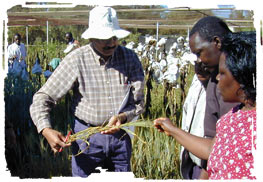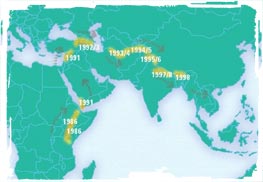El Batán, Mexico
August 31, 2005
Sounding an Alarm

Pathologists Ravi Singh and Ruth Wanyera examine wheat
infected with stem rust in Kenya. |
An expert panel
commissioned by the Rockefeller Foundation to study the
potential for a global stem rust epidemic in wheat has called
for a massive, ten-point program of action to prevent a
potential food security crisis.
The group focused
its work in eastern Africa where the new strain of stem rust
called Ug99 was first identified. The fungus, whose spores are
carried by the wind, is spreading in the region, damaging wheat
crops in Uganda, Kenya, and Ethiopia.
The greatest
danger is that the new stem rust strain will spread to intensive
wheat growing areas of Asia. The report warns, “It is only a
matter of time until Ug99 reaches across the Saudi Arabian
peninsula and into the Middle East, South Asia, and eventually,
East Asia and the Americas. However, the current crisis is a
wake-up call about the continuing, and potentially devastating,
impact that the rust pathogens can have on susceptible cereals,
and especially a staple food like wheat.”
But the report
also says it is not too late to act to prevent potential
disaster, “Plant breeders and pathologists still have time to
screen for resistant genotypes, and to get these multiplied and
into farmers’ fields,” say the panel members.
Wheat is a vital
world crop, grown, consumed, and traded around the world. Any
significant disruption in wheat production will have impacts on
global food security. A 10% reduction in global yield is
equivalent to sixty million tons of crop loss worth US$ 9
billion.
As far back as the
Roman Empire, stem rust epidemics have decimated wheat fields
over large swaths of continents. In more modern times, stem rust
has largely been controlled through the deployment of wheat
varieties specifically bred to resist the disease. It is the
breakdown of this resistance by this new string of the pathogen
that particularly alarms scientists and policymakers.

As an example of how the disease can travel, here a
virulent stripe rust starts in the highlands of East
African and makes its way to South Asia. |
An initial
analysis of global wind patterns and environmental factors
conduced by CIMMYT’s
Geographic Information Systems unit confirms there is a high
potential for the fungal spores to spread from eastern Africa
into the Arabian peninsula, Iran, and the expansive wheat
growing regions of Pakistan, India, and Bangladesh. The expert
panel report confirmed that many of the wheat varieties grown in
these regions are susceptible to the new strain of the fungus.
CIMMYT has been
screening materials in its gene bank for sources of resistance
to the new rust strain and has made some progress in identifying
promising candidates. Nevertheless, as the expert panel points
out, there is a huge job to be done in breeding, monitoring the
progress of the disease, and eventually disseminating any new
resistant varieties. CIMMYT and ICARDA, with national partners
from Kenya and Ethiopia, have convened a meeting of stakeholders
and donors from around the world to work on a plan of action
this month.
For further information,
contact Ravi Singh. |